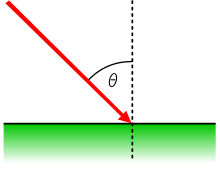Angle of incidence
The angle of incidence (or, more rarely, angle of incidence ) is the angle at which energy in the form of electromagnetic radiation or matter in the form of particle radiation or earthquake waves hit a defined obstacle. The term is used differently depending on the science or situation:
- In everyday life it describes the angle between a ray of light and the horizon . In the case of the sun, it has a decisive influence on the warming of the earth's surface due to the changing seasons. While the sun in Europe is 60–65 ° above the horizon at midday in summer and shines down at around 700 watts / m², in winter it is 13–18 ° and only 200 watts / m².
- In ray optics , the angle of incidence denotes the extension of the angle between the ray and the horizon to 90 °. When a ray passes through an optical interface, its angle of incidence is that of the perpendicular to that surface. The angle of reflection is defined in the same way - after passing through the interface. If the second medium is denser (for example in the air - lens beam path ), it becomes smaller (refraction towards the perpendicular). If the second medium is optically thinner (lens air), it will be broken by the solder. The refractive index n is the sine ratio of these two angles ( Snellius' law of refraction ). In the picture the two angles δ 1 and δ 2 are about 30 ° and 10 °. This would result in n = 2.8 - a little more than with a diamond . For air-glass, the ratio would be around 1.5: 1.
- In geology , the angle of incidence (also the angle of fall) describes the angle at which a rock layer intersects the horizontal. The angle of incidence is always between 0 ° and 90 °.
- In seismology and seismics , the angle of incidence, also often referred to here, denotes the angle between the direction of incidence of a wave and the perpendicular on the surface of the earth or an interface in the interior of the earth. For small angles the wave comes almost directly from below or above, for angles close to 90 ° the wave comes almost from the side.
